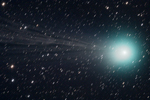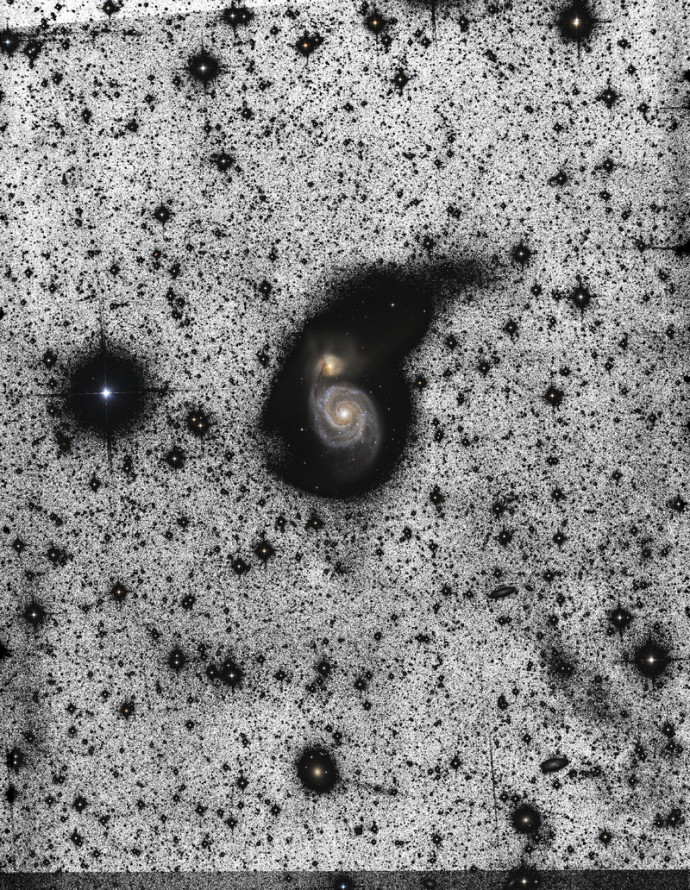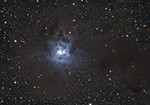Autumn skies are dominated by the milkyway high up in the sky. Especially the constellation of Cepheus reveals a variety of widespreaded molecular clouds, reflection and dark nebulae. One striking example is the vicinity of NGC 7129. This very deep image is the outcome of data imaging taken over three seasons and a combination of four telescopes, resulting in a total exposure of 51 hours at f/3.8 and f/2. Such deep imaging turns the "dark background" into real celestial objects. In that part of the sky, there is literally no empty space.
This image is the result of a further ongoing cooperation with Oliver Schneider and his "Balkonsternwarte". Especially this cooperation enables us that degree of data collection for extensive deep field imaging, and to outbalance bad weather conditions.
The extremely faint object emerging south of M51 we first described in March 2014 and estimated to be a tidal feature has recently been confirmed by astronomers of Case Western Reserve University in Cleveland, OH. This 'south plume' has a surface brightness of only 29.2 mag/arcsec². Interestingly, this feature was not predicted by standard computer models of galaxy interaction, and it is still of unknown origin (either a tidal stream or a disrupted dwarf galaxy).
This clearly emphasizes that extremely deep imaging of apparently well-known and scrutinized celestial objects may reveal new and sometimes unpredicted phenomena.
A further celestrial object we photographed with our new camera equipment: IC 434, the Horsehead Nebula in Orion. The first object of the sky in this winter at all, which could be photographed since a long period of bad weather has prevented the view of the starry sky, however, long exposures were impossible.
This is our most recent photo of comet Lovejoy, one of the very few comets during the last time that was indeed visible by the naked eye. And it was also one of the first objects of the sky that we photographed with our new equipment, a Sony Alpha 7, which we modified by ourselves to render it more H-alpha sensitive.
Find now photos of Noctilucent Clouds of 3 July 2014 in our gallery.
The Whirlpool galaxy M 51 is undoubtedly one of the most prominent targets for deep-sky imagers.
However, it is remarkable to unveil preveously unobserved and undocumented phenomena within and in the vicinity of this astronomer's "flagship".
Now this became reality by combining 3 instruments of Sternwarte Hohe Asch and Balkonsternwarte Leopoldshöhe to get more than 50 hours of
imaging data.
For clearer visualization all images are inverted and highly overscaled.
M 51 overview
South of the main disc this extremely faint arc-shaped structure could possibly be another tidal arm resulting from the interaction with NGC 5195.
Close examination of older footage reveal a glimps of these structures showed here. One good example is from Günter Kerschhuber from 2009.
NGC 5198 (left galaxy):
What seems to be a very faint starstream is emerging straight from nearly the center of NGC 5198 to the west and thus into the direction of NGC 5173.
NGC 5173 (right galaxy):
To the southwest a faint stucture is emerging from the galaxys main bulge, possibly an star association.
The possibilty of an interacting system with NGC 5198 and its starstream can not be ruled out.
The faint nature of the described features near the detection limit, plus the fact that nearly the whole field is "spilled" with intragalactic cirrus makes it at this point impossible to clarify
the true nature with certainty.
Further observations with more sophisticated instruments are an absolute necessity to get a in the words sense clearer image of these findings.
Find now vintage photos of Moon-Jupiter-Saturn-Mars Conjuction in 2000,
of comets Linear S4 and Machholz and of the Witch
Head Nebula in our gallery.
It was a great opportunity to get good pictures of the International Space Station when it's moving across the sky. We all met at the public observatory "Volkssternwarte Ubbedissen" in Bielefeld, put the camera on the 16" f/8 telescope and set the camera to continuous shooting mode. Then, we simply tracked the ISS by moving the entire telescope by hand - only guided by the Telrad viewfinder - and it worked!
Old data from the "Winter-Campaign" 2010/11 finally are ready for publishing, showing the famous galaxy-trio M65/66 NGC3628 in constellation Leo, better known as "Leo Triplet".
Exposing in 6 sessions under extremely changing conditions made the processing quite challenging. Overall, image quality is good enough to clearly visualize the starstream stetching East (up in the image) from NGC 3628.
The bright Seyfert 2 Galaxy NGC 4725 is a prominent example of a one-armed spiral and possibly responsible for the "disfigurement" of smaller NGC 4747 in the upper left, both approximately 50 million lightyears away.
NGC 4712, right of NGC 4725, is a near background-galaxy, four times distant than NGC 4725/4747, as radial velocities indicate.
From 52 degrees north, imaging objects of the southern sky is always challenging. Culminating with an altitude of only 12° NGC 253 is something special. Nevertheless, when transparency is good such endeavures are worth the risk. With its high surface brightness this treasure of the south is a primary candidate.
Although lacking in resolution the image shows a glimpse of its unsurpassed splendor.
Yesterday we made a thee hour trip to the far northwest of Germany to be sure to have a perfectly clear sky. And so it was! However, the comet itself was only visible with binoculars low on the western horizont, since it was about to set one hour after sunset.
Today, we met in Bielefeld-Ubbedissen again, where the weather was still good!
This pair of a spiral and a barred spiral galaxy currently undergoes a giant galactic collision. As a result, starburst continues - an immense rate of star formation that will persist for the next 400 million years. After that, both galaxies will form one large elliptic galaxy where star birth will almost completely cease.
Within this emission nebula, 12000 light-years away in constellation Auriga, two unique structures can be found above and right of the center in this image. These ten light-years long objects were shaped by stellar winds from the embedded young cluster NGC 1893. They are called the Tadpoles, composed of denser gas and dust, where evident star formation and birth is still continuing.
The eastern part of the Veil Nebula complex portraited here, consists of the three catalogue objects NGC 6992, NGC 6995 and IC 1340 from left to right, forming together this characteristic loop.
Allthough with less than 10° angular distance relatively near to the galactic equator, numerous backgrund galaxies can be found in this image, which suggests a rather high transparancy of this part of the milky way in the constellation Cygnus.
The years before we hadn't much luck with the Perseids - it was clouded out most of the time, or only a few meteors appeared. But not this year! Almost clear sky and lots of bright shooting stars were seen above.
This image is composed of eight pictures - each exposed one minute with a wide-angle lens and a DSLR on an equatorial mount - that were merged in post processing.
Some people might see a human eye's blue iris, some have the impression of petals this luminous reflection nebula in constellation Cepheus can evoke.
In fact, it is a young, blue star illuminating surrounding dust clouds. In some inner parts of the nebula ultraviolet light is converted into a weak reddish glow, whereas in the outer region, also
dust and cold molecular clouds weaken the light of background stars more or less.
Thousands of years ago a supernova exploded, leaving behind what is now known as the "Veil Nebula", a faint and delicate structure devided into serveral more or less prominent sections with half a dozen catalogue numbers.
This image shows the most western part NGC 6960 or the "Witches Broom Nebula" alongside with the adjacent slightly fainter nebulosity seen at the top. All these nebulas are fine examples of differentiation in the composition of the light emitting components, hydrogen and sulphur representing mainly the red colours, oxygen mainly the green and blue. The center part of NGC 6960 is nearly outshined by 4,3 mag 52 Cygni, a foreground star which has physically nothing to do with the nebula itself.
... the emmision nebula IC 1396 stretches over 3x3°. This image shows only the central part with the famous "Elephant-trunk" just below the center.
Inside this remarkable structure, also labeled as IC 1396A, very active star formation is under way, hosting several very young stars and protostars, as infrared data from the Spitzer space telescope had unveiled.
When looking at the beautiful Sunflower Galaxy M 63, you will notice a dust lane covering the highly structured spiral arms at the south edge. This lane, and also an extremely faint halo of stars around M63, are remains of a dwarf galaxy disrupted by the Sunflower Galaxy. In turn, this dwarf galaxy is not completely "eaten alive" yet, but is still visible as a faint plume south west of M 63.
The Pleiades, Seven Sisters or Messier 45 were well known in all cultures all over the world since the dawn of civilization and played a major role in determing yearly cycles. Therefore it is the first deep-sky object ever imaged by mankind. This image can be found on the Nebra sky-disc, which was manufactured around 1600BC.
Since then imaging techniques had slightly improved, revealing wide spread gas filaments around the star cluster, shining in a blue light, reflecting the intense radiation of the hot young cluster members. These reflection nebulas are part of a huge interstellar "flux" in the Perseus/Taurus region.
Have a look at the beautiful Galaxy M 33 in Constellation Triangulum and enjoy. Under exceptionally good viewing conditions with no light pollution, the Triangulum Galaxy can be seen with the naked eye. But it is very difficult here in Germany, on viewing location Hohe Asch, too.
The Triangulum Galaxy is the third-largest member of the Local Group of galaxies, which includes the Milky Way Galaxy, the Andromeda Galaxy and about 30 other smaller galaxies.
Let's have a look at globular cluster M 3 in Canes Venatici, Pinwheel Galaxy M 101 in Ursa Major, Pacman Nebula NGC 281 in Cassiopeia, Crescent Nebula NGC 6888 and the double cluster (the juwel-case) NGC 869 / 884 in Perseus.
The so called Soul Nebula is one of several wide emission complexes in the constellation Cassiopeia. Though smaller than its nothwestern neighbour the "Heart Nebula", it doesn´t fit into the field of 60x90 arcmin. It is illuminated bei several smaller star clusters in the center area. Here the interstellar gas is relatively thin and faintly structured. It seems, that stellar winds are blowing the gas apart and to the "rims", where lots of pillarlike struktures and dark dust clouds are present, with IC 1871 as one of the most noticable ones on the upper left.
There are four reflection nebulas in this small area in constellation Monoceros (the Unicorn). The two large ones, IC 446 and 447, were discovered accidently twice - by astronomer E. E. Barnard,
and therefore further labeling was given to them, namely IC 2167 and 2169. Since astronomer John Dreyer published Barnard's discovery in his second Index Catalog, the latter one was later referred to
as "Dreyer's Nebula".
Both small nebulas are listed in the New General Catalog as numbers 2245 and 2247.





































































